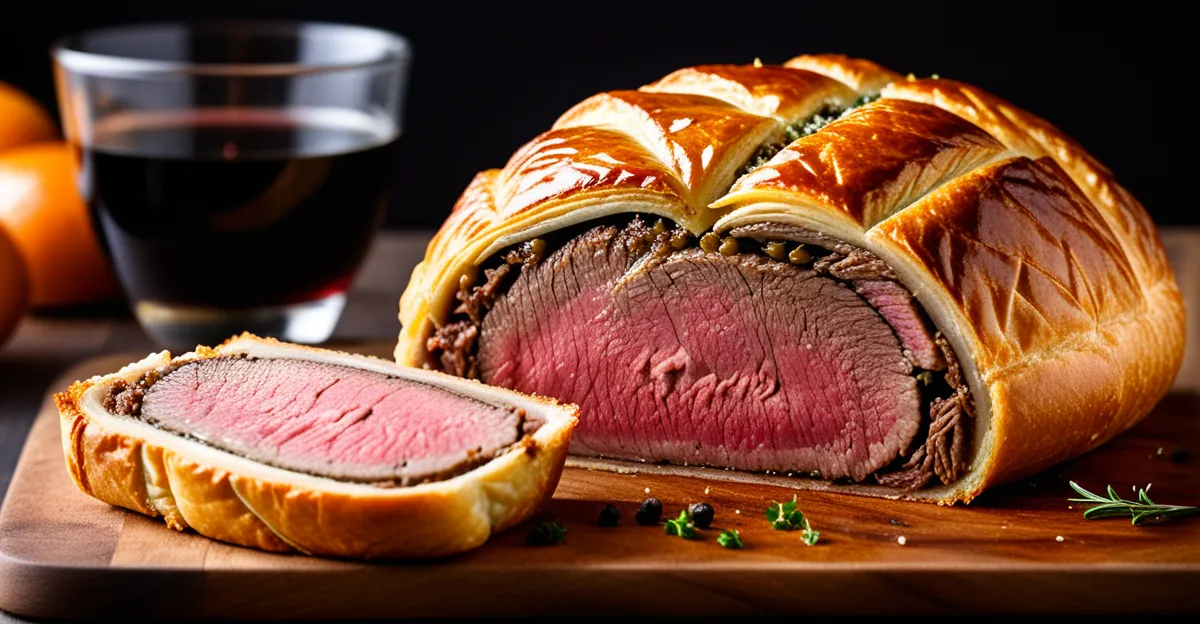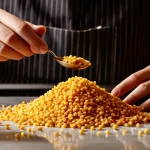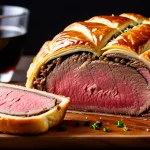Ingredients for Beef Wellington
Crafting a traditional Beef Wellington requires a precise selection of ingredients to ensure its distinct flavor components shine through. The dish is renowned for its tender beef center wrapped in a delicate pastry, which marries textures and tastes seamlessly.
At the heart of beef Wellington ingredients is a high-quality beef tenderloin, ideally well-marbled and fresh. Selecting premium beef is crucial for achieving the right tenderness and juiciness. Additionally, the dish traditionally calls for mushroom duxelles, a finely chopped mixture of mushrooms, herbs, and shallots sautéed in butter, bringing an earthy depth to the flavor profile.
Also read : How do you make a traditional Lancashire hotpot from scratch?
To wrap the beef, prosciutto or Parma ham is often used, adding a layer of savory intensity. This is enveloped in puff pastry, which, when properly handled, provides the iconic flaky crust that encapsulates the beef. For those seeking to elevate the dish further, a brush of Dijon mustard on the seared beef introduces a subtle zing, enhancing the overall flavor.
For variations, consider adding ingredients like foie gras, which contributes a rich, buttery profile, or a layer of pâté to deepen the umami notes. Options such as truffles or shallots can also be incorporated for a unique twist, catering to personal taste preferences.
In the same genre : How Do British Ingredients Influence Global Culinary Trends?
Paying attention to these essential and optional cooking supplies elevates the traditional Beef Wellington, resulting in a dish that’s both classic and customizable to suit any culinary inclination.
Preparation Techniques
Approaching Beef Wellington preparation with care is crucial to ensure a perfectly cooked and beautifully presented dish. Key cooking techniques include proper seasoning and searing of the beef, as well as mastering pastry handling.
The preparation begins with seasoning the beef with salt and pepper. This enhances its natural flavors. Next, sear the tenderloin evenly on all sides in a hot skillet. This step is essential for developing the Maillard reaction, which adds a deep, savory taste.
When it comes to the pastry, opt for a high-quality puff pastry or make your own. Handling the dough correctly is critical; if it’s too warm, it becomes difficult to manage, resulting in a less-than-ideal crust. Keep it chilled until right before use. Roll it out on a floured surface to a thickness that offers structure but doesn’t overpower, typically around ¼ inch.
Assembling the Wellington demands attention to detail to avoid leaks. Ensure the beef, duxelles, and prosciutto layers are tightly wrapped without gaps. Overlapping the pastry edges securely and sealing with egg wash helps maintain the integrity of the assembly. With these preparation techniques, you’re poised to create a Beef Wellington that impresses both in taste and technique.
Cooking Instructions
Preparing and cooking Beef Wellington involves several meticulous steps to ensure optimum results.
Pre-cooking Steps
Before baking, it’s essential to properly assemble the Wellington. Lay the beef tenderloin—wrapped in prosciutto and topped with mushroom duxelles—onto prepared pastry. Ensure the pastry is sealed tightly around the beef to prevent leaks. A brush of egg wash creates a cohesive and glossy finish.
Baking Process
Baking instructions are crucial: Preheat the oven to around 400°F (200°C) for optimal pastry flakiness. Place the assembled Wellington on a baking sheet, seam side down, to encourage even cooking. Bake until the pastry is golden brown and the beef reaches desired doneness, typically medium-rare. Use a meat thermometer to verify the beef’s internal temperature reaches about 135°F (57°C).
Resting Period
After baking, a resting period is important for flavor preservation and structure. Allow the Wellington to rest for about 10 minutes; this ensures the juices redistribute within the beef, resulting in a tender and succulent slice. Cutting too soon can lead to a loss of flavorful juices, negatively impacting texture.
Presentation and Serving Suggestions
When it comes to beef Wellington presentation, a little creativity goes a long way in turning this classic dish into a visual masterpiece. Focus on elegant plating to showcase its appeal, particularly for special occasions. Here are some ideas to get you started:
-
Plating Technique: Slice the Wellington into even pieces, revealing the layers of beef, prosciutto, and golden pastry. Arrange the slices neatly on a plate for a polished look.
-
Recommended Side Dishes: Enhance the dish with complementary sides such as roasted asparagus, creamy mashed potatoes, or a fresh green salad. These not only add color but provide a balanced meal.
-
Sauces: A rich red wine reduction or a creamy mushroom sauce can elevate the flavors of your beef Wellington, accentuating its savory components.
-
Garnishing Tips: Add a touch of greenery with fresh herbs like rosemary or thyme. Edible flowers can add a pop of color and fragrant aroma, making your presentation more enticing.
These serving ideas not only enhance the visual appeal of beef Wellington but also ensure a delightful dining experience.
Common Mistakes to Avoid
Crafting a perfect Beef Wellington can be challenging, as several beef Wellington errors often occur in the process. Understanding these pitfalls can prepare you for a more seamless cooking experience.
One common mistake is overcooking the beef. To avoid this, use a meat thermometer to ensure precise timing, aiming for a medium-rare center which is around 135°F (57°C) internally. Overcooking results in a dry, less flavorful tenderloin.
Another pitfall is soggy pastry. To combat this, make sure to properly wrap the beef and ensure the puff pastry is chilled before use. Also, avoid adding too much moisture with ingredients like mushroom duxelles by thoroughly sautéing them.
Troubleshooting tips include handling the pastry with care to prevent any tears or leaks. Overlapping the edges securely and sealing with egg wash is essential in maintaining the dish’s structural integrity. Monitoring oven temperature and timing is crucial for achieving that iconic golden crust.
Being mindful of these cooking advice pointers helps in sidestepping common errors, ensuring your Beef Wellington’s texture and flavors are consistently delightful.
Variations on Beef Wellington
Exploring beef Wellington variations allows culinary enthusiasts to experiment with unique flavors and cater to diverse dietary preferences. This classic dish serves as an excellent canvas for creative twists, bringing new life to its elegant tradition.
One way to reinvent beef Wellington is through alternative fillings. While the standard recipe features rich mushroom duxelles and savory prosciutto, incorporating ingredients like foie gras or truffles can immediately elevate the dish with opulence and depth. These additions contribute nuanced earthy tones and a buttery richness, enhancing the overall flavor profile.
For those interested in alternative recipes for different diets, consider a vegetarian version. Replace the beef with a hearty portobello mushroom or a blend of root vegetables to maintain a satisfying texture. Pair this with a mixture of sautéed spinach and goat cheese for a robust taste that doesn’t skimp on flavor.
Cultural twists also offer an interesting path. Infuse cooking techniques from various cuisines to create something exceptionally unique. For example, incorporating Asian flavors like miso or soy can provide a delightful umami kick, whilst using curried lentils adds an aromatic, spicy element, perfect for adventurous palates.
These variations not only broaden the appeal of beef Wellington but also offer delightful possibilities for any cook seeking to personalize this esteemed dish.




